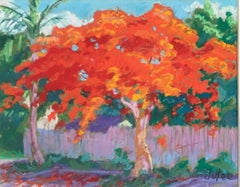Julee Docking On Sale
Recent Sales
1980s Post-Impressionist Mixed Media
Oil Pastel, Gouache, Archival Paper
Julee Docking for sale on 1stDibs
Julee Docking was born in Bethesda, Maryland. She studied at the Corcoran Art School, Washington D.C. and private lessons at the High Museum in Atlanta, Georgia. She is a member of the National League of American Pen Women, Women’s Caucus of Art, Sarasota Art Association, Longboat Key Art Center and the Florida Art Group. She has had numerous exhibitions and awards. The Grumbacher Gold Medallion, Cornell Museum, the Hilton Leech Memorial Award and Edison College. Her artwork has been exhibited at the Kennedy Center, Washington, D.C., the Ringling Museum, Sarasota, the High Museum, Atlanta, Georgia, the Jacksonville Museum, Florida and the Boca Raton Museum, also in Florida.
A Close Look at post-impressionist Art
In the revolutionary wake of Impressionism, artists like Vincent van Gogh, Georges Seurat, Paul Cézanne and Paul Gauguin advanced the style further while firmly rejecting its limitations. Although the artists now associated with Postimpressionist art did not work as part of a group, they collectively employed an approach to expressing moments in time that was even more abstract than that of the Impressionists, and they shared an interest in moving away from naturalistic depictions to more subjective uses of vivid colors and light in their paintings.
The eighth and final Impressionist exhibition was held in Paris in 1886, and Postimpressionism — also spelled Post-Impressionism — is usually dated between then and 1905. The term “Postimpressionism” was coined by British curator and art critic Roger Fry in 1910 at the “Manet and the Postimpressionists” exhibition in London that connected their practices to the pioneering modernist art of Édouard Manet. Many Postimpressionist artists — most of whom lived in France — utilized thickly applied, vibrant pigments that emphasized the brushstrokes on the canvas.
The Postimpressionist movement’s iconic works of art include van Gogh’s The Starry Night (1889) and Seurat’s A Sunday on La Grande Jatte (1884). Seurat’s approach reflected the experimental spirit of Postimpressionism, as he used Pointillist dots of color that were mixed by the eye of the viewer rather than the hand of the artist. Van Gogh, meanwhile, often based his paintings on observation, yet instilled them with an emotional and personal perspective in which colors and forms did not mirror reality. Alongside Mary Cassatt, Cézanne, Henri Matisse and Gauguin, the Dutch painter was a pupil of Camille Pissarro, the groundbreaking Impressionist artist who boldly organized the first independent painting exhibitions in late-19th-century Paris.
The boundary-expanding work of the Postimpressionist painters, which focused on real-life subject matter and featured a prioritization of geometric forms, would inspire the Nabis, German Expressionism, Cubism and other modern art movements to continue to explore abstraction and challenge expectations for art.
Find a collection of original Postimpressionist paintings, mixed media, prints and other art on 1stDibs.
Finding the Right mixed-media for You
Mixed media is a type of art that sees artists using a range of materials or more than one medium. Find a range of mixed media paintings and other artworks for your space today on 1stDibs.
Mixed media is distinct from multimedia, which describes art involving electronic media, including video, computers and digital elements. Artists combine painting, drawing, photography and sculpture for mixed media art. Instead of sticking to one form, they aim to break boundaries and create unique pieces. Pop art is one of the vibrant periods for mixed media art, with Jasper Johns and Robert Rauschenberg among its most fabled producers. Rauschenberg, like many mixed media artists, used found objects in his work, from cast-off furniture to newspapers.
Collage is one of the most well-known areas of mixed media. Artists use various types of paper, fabric, photographs and more to create one cohesive work. A type of collage is assemblage, which involves 3D objects.
While artists may use fabric in collage, it can be the very substance of the art itself. Fabric art makes extensive use of texture. Artists may paint or embroider on fabric to create layers of texture and color to evoke a specific feeling. They can also transfer photos onto fabric for innovative ways to display visuals.
Resin-based art has clean, sharp lines and a definitive shape. Resin is a liquid that hardens to a high-gloss surface and is used to seal wood, counters and floors. Resin can also seal artwork, and many artists tint it using pigment powder, ink, spray paint and other vivid materials. If water is added, the resin will turn milky instead of being completely transparent. It’s common for artists working in mixed media to use resin on nontraditional surfaces like glass, wood, metal and stone. This creates a shine that’s perfect to brighten a dull space in the home or office.
Find mixed media paintings and other art for sale on 1stDibs.
